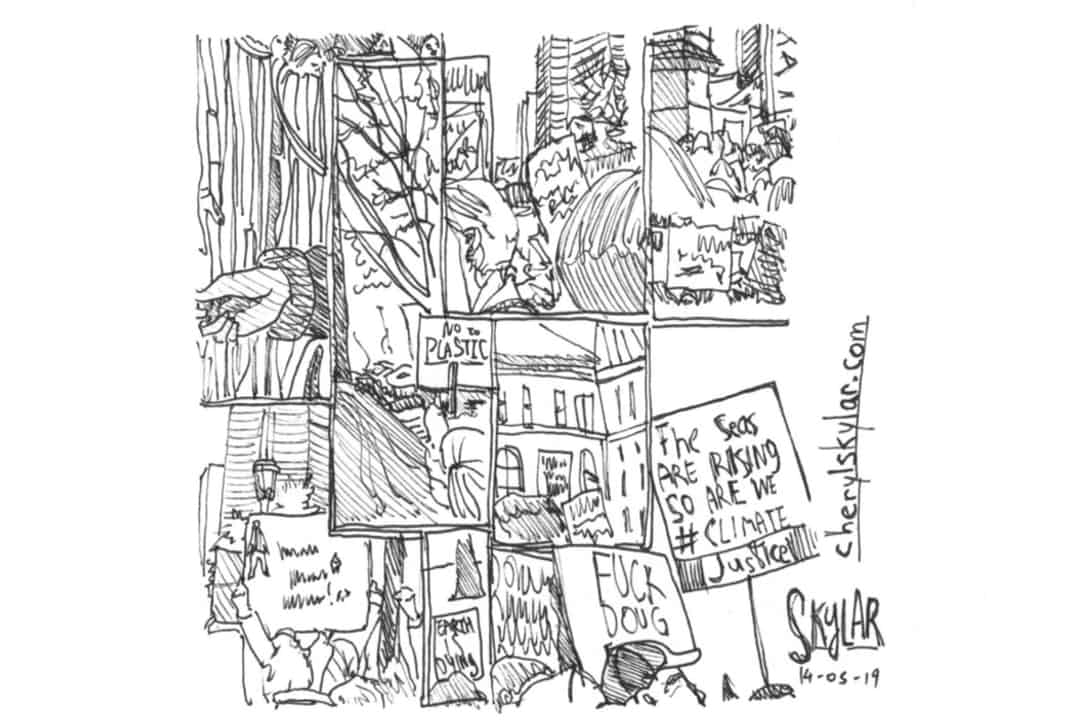Fridays for Future is a movement started by 15 year old Greta Thunberg, who sat for three weeks outside of the Swedish parliament to challenge their inaction on climate change. Her courage and determination sparked an international student activism movement.
In Toronto, the Fridays for Future school strike for climate change action began on May 3 at Queen’s Park. It coincided with Doug Ford’s meeting with the recently-elected Alberta Premier, Jason Kenney, as they discussed their objections to the recently-enacted federal carbon tax. The strike concluded at Nathan Phillips Square, in front of City Hall.
These protesters highlighted the fact that even if they collectively decided to recycle, stop using straws, and go vegan, it would not be enough to contest the amount of damage that large-scale carbon emissions have done to the earth. Just 100 businesses alone have contributed to 71 per cent of our world’s global emissions since 1988.
Statistics like this can leave some feeling hopeless, but it ignited a movement among thousands of students around the world. These students refused to let the world decide their future. They refused to be left with the scraps of a dying planet. The march on May 3 was just a glimpse of their potential for enacting change. This is a continuous fight on all fronts, and it is being led by those who will be affected the most.
In 11 years, the damage to the Earth caused by climate change will be irreversible. It is the terrifying end to a story that began with the birth of the industrial age. From the early eighteenth century to now, generations have witnessed the development of what the National Centre for Climate Restoration calls a “near- to mid-term existential threat to human civilization.”
It may seem excessive to phrase it that way, but it is the unfortunate, daunting truth. Scientists around the world have made it clear that if we do not stop the current trajectory of greenhouse gas emissions there will be permanently detrimental consequences.
We already see some of these consequences today, with frequent wildfires on the west coast, record-breaking hurricanes, floods with tolls on thousands of lives, and a severe lack of crops, a major instigator behind the modern refugee crisis.
As reported by the Intergovernmental Panel on Climate Change, the international goal is to reduce warming to under two degrees Celsius and afterward to not allow warming to rise above 1.5 degrees Celsius. It seems impossible, but in order to even begin the process, “every sector of the economy needs to get to zero emissions if we are to stabilize our climate” according to Akshat Rathi, reporting for Quartz.
It is an intimidating task laid before all of humanity, and yet the response in political spaces has been lackluster.
U of T has witnessed a small protest campaign centred around divesting from fossil fuel companies led by the climate activist group Leap UofT. However, the scale and reach of the movement, unfortunately, does not compare to that of Fridays for Future and is only the second campaign of its kind on campus, following the UofT350 campaign. The truth is, we are nowhere near leading the charge. We are not doing enough.
Just before the march began, the voices that spoke from the microphone placed at the top of Queen’s Park were young, innocent, and enraged. They screamed, they begged, they chastised, and they joked at all those who claimed to work for the betterment of their future.
They spoke on a range of issues in quick, concise speeches. Topics included fast fashion, the effect of the meat industry on global emissions, the Green New Deal, and why divesting from the corporations leading in greenhouse gas emissions was vital for the fight against climate change. All this, when they should have been busy being kids.
Signs are one of the most important parts of a protest, and at the Friday for Future protests it was no different. One replaced the faces on the popular ‘distracted boyfriend’ meme with Doug Ford, money, and our dying earth. Another displayed earth imagined as an ice cream cone with the caption “Noo, I’m melting.” Then there were those with simple, heartbreaking messages, such as “I want to meet my grandchildren.”
That is the core message of Fridays for Future: to let the world see who would be left to deal with the ramifications of a dying earth. At the heart of protest signs covered in memes and the innocence of various misspelled words were children, standing in front of adults who have determined their future, begging for their lives.
As the world faces the consequences of negligent production and selfish policies, children, armed with seemingly more knowledge and worldly understanding than our public servants, are rallying. The question to be asked is where do we, the students who should be empowered by the privilege to learn more, question more, and fight for more, stand. We, as fellow students, must follow in the footsteps of the brave, impassioned students at Fridays for Future in combating climate change. This movement is for all of us, and we must do a better job.
It can be comforting to see youth rising against the injustices of the world. It can make you feel hopeful that the future will be filled with bright minds ready to challenge any obstacle that comes their way. You must not forget that this is not what they should be doing. At the end of the day, it is upsetting to see so many children forced to protest in the streets, because instead, as dozens of signs read, they should be at school.
Nadine Waiganjo is a second-year Social Sciences student at University College.


